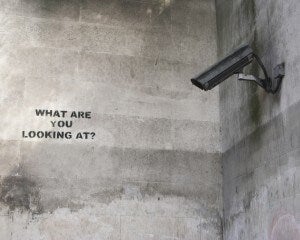Are you being filmed right now? Are you sure?
Or, more importantly: does that thought make you nervous? You might want to get used to it. As camera technology gets better and better, it’s also getting smaller and cheaper. Digital cameras – a novelty item as little as a decade ago – now surround us wherever we go. They’re built into our phones and our laptops. They watch over our homes and businesses, our ATM withdrawals, and every major intersection of our cities. That red light you blew last week? The ticket is in the mail.

Take the Mini DV, the self-proclaimed “world’s smallest video camera” rolled out in Hong Kong this month. About the size of your thumb, it captures up to 8 gigs of video feed and boasts an impressive 2-megapixel resolution. It has a two-hour battery life, and uploads your adventures via USB 2.0. It even clips to your clothing so you can show your friends exactly how “dope” your skydiving trip was.
But the ubiquity of digital cameras isn’t just changing how we document Spring Break. It’s changing how news breaks. The first on-site images of the Mumbai terror attacks last year didn’t come from the BBC or Associated Press; they came from Flickr, with front line coverage by amateur photographers. When Oscar Grant was killed by a police officer on New Years Day, digital video in the hands of Oakland subway passengers captured the tragedy first-hand – and made CNN.
The implications get complicated, and fast.
On the one hand, it puts a certain power back into the hands of everyday people. Champions of web 2.0 praise the bottom-up nature of this new media – after all, what better way to capture the truth than by the democratic method of public participation? We all become pseudo-reporters, blogging and uploading the view from the streets. Sexual harassment lawsuit? Ladies and gentlemen, I direct your attention to YouTube exhibit A.

But what ever happened to good old American privacy? After all, you blew that red light when no one was around… shouldn’t you get away with it? I spoke with Dr. Richard Doyle, a Penn State professor who studies bioethics and technology, about the risks of these new technologies. “Yes, they are a danger, though of course privacy is itself as much a product of technology (think of the envelope) as publicity is,” he said. Doyle emphasized that these technologies can also offer a new form of anonymity, what he calls peer-to-peer privacy networks. “The technologies and their governance are still emerging, so now is the time to work towards maximizing creative anonymity as well as trying to ‘protect’ privacy.”
I see his point. After all, Flickr doesn’t ask for a social security number before you upload pictures of your new bong. Anonymity is built into web 2.0, and it offers us a new kind of freedom when we upload home-made media. Still, aren’t we always on both sides of the camera? This seems to be the fundamental paradox of these emerging technologies: on the one hand, the creeping paranoia of a surveillance state, and on the other, the newfound freedoms that come with a camera in your pocket at the right moment. Doyle called it “a surreal mixture of total transparency and radically increased anonymity.” Surreal, indeed.
So will every living moment of our lives soon be on the record? Maybe someday, you won’t need to wait until your deathbed to have your life flash before your eyes; you can just consult your video archives. And what are the legal implications of a a fully recorded human life? What if life-filming became a mandatory legal precaution? Sure, you could always prove your alibi, but what if you failed to record last Friday night? Trying to hide something? Hmmmm? The legal world is constantly playing catch-up with accelerating technologies (e.g. should Craig Ventor be allowed to patent DNA?)… The time is coming to decide how we think ubiquitous audiovisual recordings should fit into the landscape of our legal system.
Even if we so desired, could we put some restrictions on how and where these technologies deploy? “Restricting and regulating these technologies is unlikely to be any more successful than Hollywood and the RIAA attempting to restrict the sharing of mp3 and videos,” says Doyle. “Those of us concerned and interested in these emerging technologies should instead work toward bringing the maximum collective intelligence and creativity to bear on their use.”
So tomorrow, and the day after, you’ll see (or won’t) a few more eyes in the sky. They’ll be watching you, but that’s okay. You can watch them right back. Now if you’ll excuse me, I have a traffic ticket to pay.


